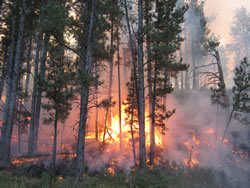
National Fire Plan Success Story
Largest Prescribed Fire in Park's History - a Huge Success
Wind Cave National Park, South Dakota
National Fire Plan - Fuels Reduction
2011

Surface fire moves upslope from burn perimeter consuming large woody debris and ponderosa pine seedlings.
The largest prescribed fire in the history of Wind Cave National Park was completed October 20-21, 2010. The 3,450-acre American Elk unit was located primarily within forested communities of the park but also included mixed-grass prairie, prairie dog towns, and meadows where ponderosa pine had encroached. Over one hundred personnel helped out with the burn including those from four National Park Service units, two Bureau of Indian Affairs units, the Black Hills National Forest, and Custer State Park. The first day of the fire consisted of two ignition teams blacklining approximately 12 miles of unit perimeter. Day two involved blacklining the final half-mile of the unit perimeter and interior helicopter ignition.
The primary objective for the fire was to restore fire back into the project area where fire has been excluded since the park’s creation. Additional resource objectives included reducing overstory, midstory, and seedling densities. The park also wanted to reduce both dead and down fuel loads within the forested communities and encroachment of ponderosa pine regeneration at the forest-prairie ecotone.
The natural fire regime and forest structure at Wind Cave from the mid-1500s to the late 1800s consisted of frequent surface fires and mostly open-canopy ponderosa pine stands with large diameter trees. With land settlement in the area in the late 1800s, the frequent surface fire regime ceased which changed the forest structure to dense, closed canopy stands consisting of unusually high numbers of small diameter trees. As a result, the crown fire potential has dramatically increased and the park’s forested areas are now subject to high severity stand-replacing wildfires. Prescribed fires at Wind Cave during the spring and fall months are an integral tool for restoring these forests to their naturally diverse structure.
The large size of this unit allowed the prescribed fire to burn over multiple burn periods and weather conditions, which replicates natural fire activity. The use of a helicopter allowed the park to achieve variable fire severities across the landscape due to varied ignition patterns and provided firefighter safety by eliminating the need for interior hand ignition. There are over seventy-five fire effects monitoring plots located within the unit which will be used to assess the monitoring objectives within the next year.
Contact: Dan Swanson, Fire Ecologist, Northern Great Plains Fire Management, (605) 745-1172.